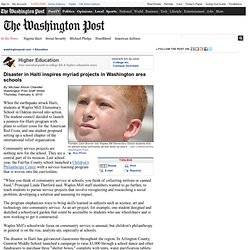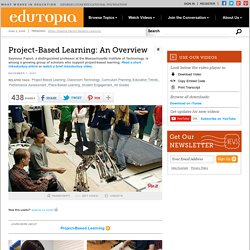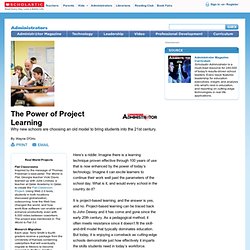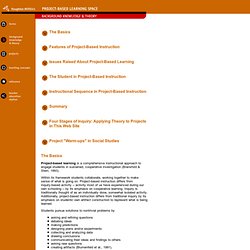

Moving Beyond the EBacc – A Curriculum Fit for the 21st Century. Can you apply Google's 20% time in the classroom? I love learning and am a big advocate of creativity.

So when I read about Google's concept of '20% Time' I knew I had to find a way of sneaking it into the ethos of my classroom. In short, Google offers its engineers 20% of their timetable to work on their own projects – things that they are truly passionate about and not things necessarily in their job description. Fairly radical. And I couldn't help thinking, if it works for Google, could it work for education?
Theme Study « The Nautical 11. 10 Takeaway Tips for Project-Based Learning. At King Middle School and Casco Bay High School, in Portland, Maine, every student works in a widely hailed project-learning method called expeditionary learning.

Discover what your school can learn. Editor's Note: Special thanks to the Buck Institute for Education for its assistance with compiling this list. Casco Bay students relax, work, play, and eat in the central lounge. Credit: Michael Warren It may be diminutive, but the state of Maine is hardly diffident. Six Steps for Planning a Successful Project. Sure, King Middle School has some amazing projects, but the Portland school has been refining its expeditionary learning projects for nearly two decades.

David Grant, who guides the school's technology integration and curriculum development, has put together a six-step rubric for designing a project. He says Fading Footprints, which became a model for King and Expeditionary Learning Schools, doesn't take an entire school, or even a team of twelve, to plan and carry out; one or two teachers can tailor this one to fit their time and resources. Practical PBL: The Ongoing Challenges of Assessment. In recent years, most students in my project-based AP Government classes have indicated, in both class discussions and anonymously on surveys, that they prefer project-based learning to a more traditional classroom experience.

They find PBL more fun and believe that it leads to deeper learning. However, two types of students often resist this model. Students of the first type generally do not enjoy school at all, and are looking for the path of least resistance. Because a PBL classroom is student-centered and calls on students to produce, less-motivated students will find it more difficult to "hide" and be left alone.
The second type of student has already been very successful in traditional classrooms and is deterred by the challenges of this new model. Disaster in Haiti inspires myriad projects in Washington area schools. When the earthquake struck Haiti, students at Waples Mill Elementary School in Oakton moved into action.

The student council decided to launch a pennies-for-Haiti program with plans to collect coins for the American Red Cross, and one student proposed setting up a school chapter of the international relief organization. Community service projects are nothing new for the school. They are a central part of its mission. Last school year, the Fairfax County school launched a Children's Philanthropy Center with a service-learning program that is woven into the curriculum.
"When you think of community service at schools, you think of collecting mittens or canned food," Principal Linda Thetford said. The program emphasizes ways to bring skills learned in subjects such as science, art and technology into community service. Waples Mill's schoolwide focus on community service is unusual, but children's philanthropy in general is on the rise, analysts say, especially at schools. Ripped from the Headlines: How to Turn Current Events into Real-World Projects. When the Deepwater Horizon oil well exploded in the Gulf of Mexico earlier this year, teachers across the country recognized an opportunity to bring real-world applications of math and science into their classrooms.

Similarly, the rescue of 33 Chilean miners has triggered student discussions about everything from heroism to human biology. In the wake of such dramatic events, some teachers are eager to do more than host current-events-style conversations. They want to use the news as a launching pad for in-depth student learning. But making that happen requires teachers and students to dive into topics for which there are no texts or guidebooks. What's more, maintaining student interest can be challenging once the headlines start to fade and media attention shifts to tomorrow's hot topic. How do you plan for academically rigorous projects that are "ripped from the headlines"? Look for Messy Problems. Students Thrive on Cooperation and Problem Solving. Project-based learning teaches kids the collaborative and critical-thinking abilities they'll need to compete.

Credit: Veer Let's assume the No Child Left Behind Act works fine and that by 2014 every student meets the targeted standards and passes his or her state's exit exam. Will those students be successful as citizens and workers in the twenty-first century? Not a chance. Let's further assume that each state's governor gets the one-on-one computer bug and equips all of each state's students with top-flight portable PCs. Again, not a chance.
No matter how sophisticated the tools we put in classrooms, the curriculum designed to educate students to meet the new standards is sorely inadequate to help them after they leave school. These include learning and thinking skills, information- and communications-technology literacy skills, and life skills. Project-Based Learning: An Overview. Student: We would place the dome right here, for instance.

Narrator: These sophomore geometry students in Seattle, have a problem. And they're excited about solving it. Eeva: The problem that they have to solve, is how do you design a state of the art high school in the year 2050, on a particular site. An Introduction to Project-Based Learning. The Power of Project Learning. By Wayne D'Orio Here’s a riddle: Imagine there is a learning technique proven effective through 100 years of use that is now enhanced by the power of today’s technology.

Imagine it can excite learners to continue their work well past the parameters of the school day. What is it, and would every school in the country do it? It is project-based learning, and the answer is yes, and no. Background Knowledge & Theory. The Basics.

Letting Go: Student Designed Project Based Learning. Listening to the stories of Holocaust survivors is always inspirational, but today (Tuseday 25th September) was more enlightening than usual. Along with colleague Rosie Sheldrake, I took a group of Year 9 students to an oral history event at Essex University, in memory of the late Dora Love. The original plan was to give students access to quality material for a Holocaust project that we would define later, however, as the day unfolded, we decided to hand over the whole process of project design to the students – something we have not done before. Below is a quick explanation of how we went about it… Firstly, we asked what elements of the talks had really struck students and why.
Next we explored the title of the session, ‘Building Bridges,’ and began to form these vague words into ideas. We then divided the students into four smaller groups and asked them to formulate an idea for a project. The Six A's of Designing Projects. Main Course Not Dessert.